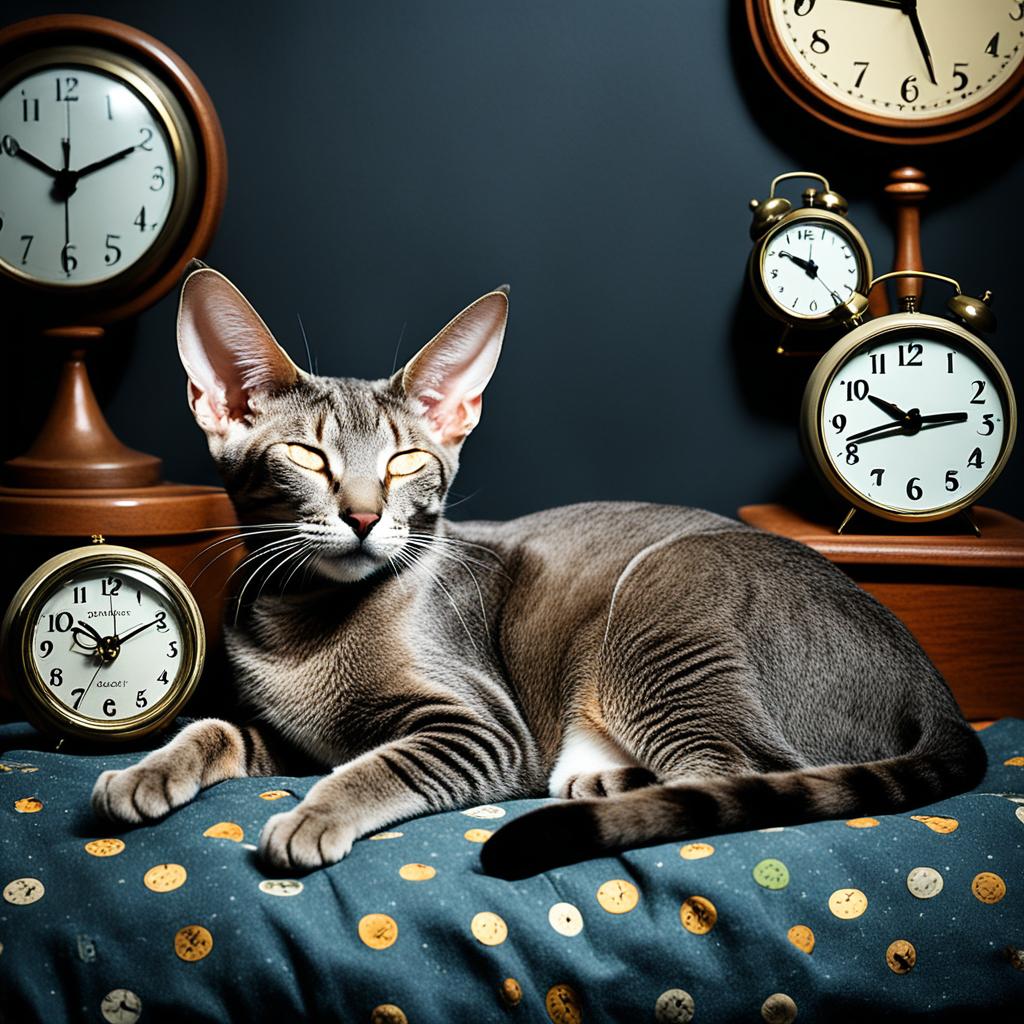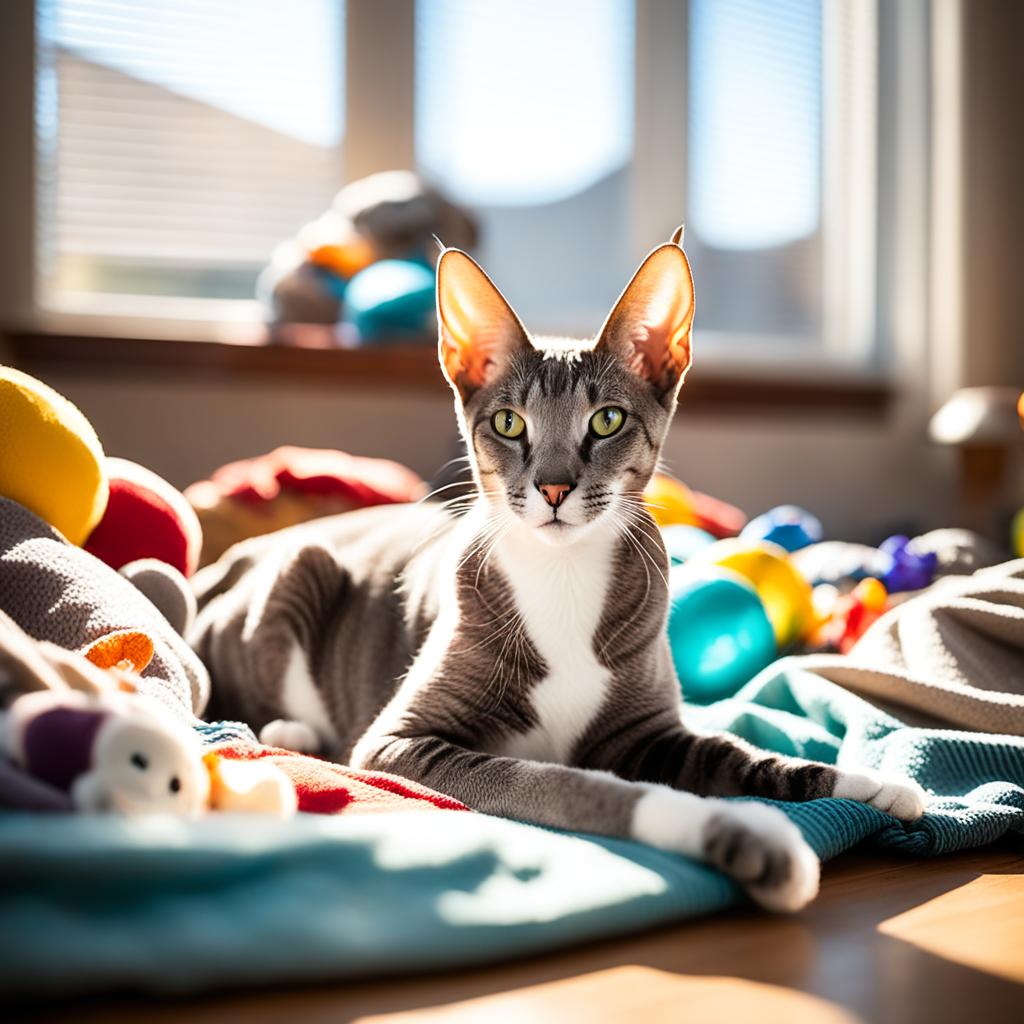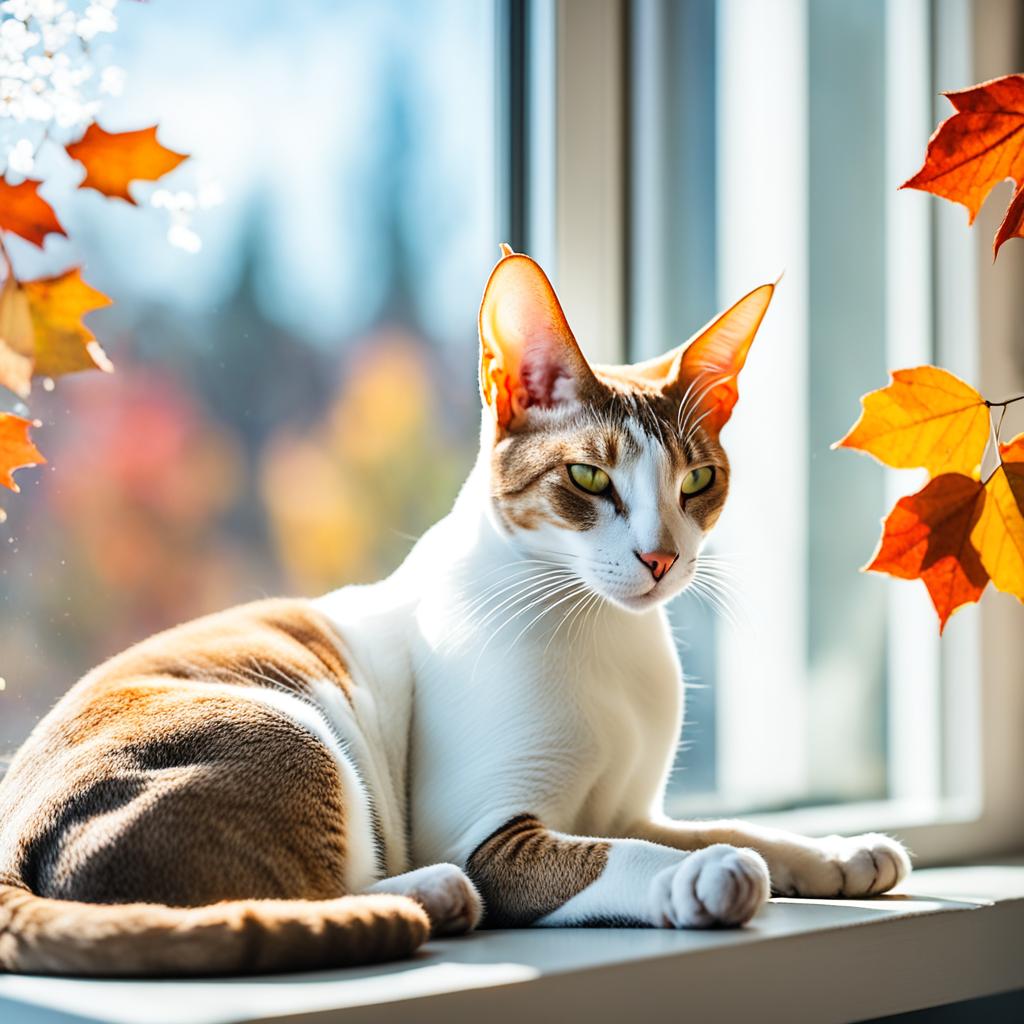Have you ever caught your Oriental Shorthair cat napping endlessly and wondered, “Is all this sleeping normal?” As a cat owner, it’s natural to be curious about your feline companion’s sleep patterns. With their sociable and energetic nature, Oriental Shorthairs might seem an odd candidate for excessive snoozing. Yet, just like other cats, they have unique sleeping needs that can leave you scratching your head.
In this section, we dive into the intriguing world of feline sleep behavior, specifically focusing on why your Oriental Shorthair may be clocking in more nap hours than you expected. Understanding these patterns is essential for providing the best pet care and ensuring your feline friend is both happy and healthy.
Key Takeaways
- Oriental Shorthair cats, despite being energetic, need significant sleep just like other felines.
- Understanding your cat’s sleeping patterns can enhance your pet care routine.
- Excessive sleeping in Oriental Shorthairs isn’t always a cause for concern.
- Monitoring sleep behavior helps cat owners maintain their pet’s health and happiness.
- This section sets the groundwork for comprehending potential reasons behind long nap times.
Understanding Oriental Shorthair Sleep Behavior

Oriental Shorthair cats, with their sleek physique and striking features, have a unique approach to napping that sets them apart. You may find your Oriental Shorthair cat transitioning between short dozing periods and deeper sleep cycles throughout the day. To help you better understand these dynamics, let’s dive into their typical sleep patterns and average sleep duration.
Inside a Day: Typical Sleep Patterns
An Oriental Shorthair’s sleep behavior is characterized by a series of irregular naps. Unlike humans, cats experience two main types of sleep: light dozing and deep sleep. During the dozing phase, which comprises a considerable portion of their rest, their brains remain relatively alert. This allows them to return to an active state at a moment’s notice, ensuring they stay prepared for any sudden activities. In contrast, the deep sleep stage is when they truly recharge, contributing significantly to overall cat health.
How Long Do Oriental Shorthairs Sleep?
On average, Oriental Shorthair cats clock in between 12 to 16 hours of sleep daily, similar to other feline counterparts. However, this number can vary depending on factors such as age, health status, and activity levels. Kittens and older cats, for instance, tend to sleep more as they undergo growth or cope with aging. To give you a clearer picture, here’s a comparative look at typical sleep durations:
| Cat Age | Average Sleep Duration (Hours) |
|---|---|
| Kitten | 16-20 |
| Adult | 12-16 |
| Senior | 16-18 |
Understanding these patterns helps ensure your Oriental Shorthair cat maintains optimal health and well-being. Recognizing when your cat is transitioning between different stages of sleep can also provide insights into their everyday behavior and overall health.
Why Is My Oriental Shorthair Cat Sleeping So Much?

If you’re puzzled by your Oriental Shorthair cat sleeping more than usual, you’re not alone. While it’s common for cats to spend a large part of their day napping, discerning what’s typical from what’s excessive is crucial.
Is It Normal?
When it comes to excessive sleep, it’s essential to know that felines, including the Oriental Shorthair, can sleep anywhere from 12 to 16 hours daily. Some even surpass this mark. Much of this time is spent in light sleep, allowing them to wake and be alert quickly if needed. An Oriental Shorthair cat sleeping extensively isn’t immediately a cause for alarm, as long as it fits within this range and the cat shows typical feline behavior when awake.
Factors That Influence Sleep Duration
Various factors can impact a cat’s sleep duration:
- Age: Kittens and older cats often sleep more than their prime-age counterparts.
- Lifestyle: A highly active cat during waking hours might need more rest.
- Health Status: Diseases, discomfort, or even certain medicines can increase sleep time. Regular pet care checkups help identify these issues.
Understanding these elements helps you see whether your pet’s behavior is a sign of underlying issues or just part of their natural lifecycle.
Check their activity levels, observe any sudden changes, and always consider consulting with a vet if you suspect the sleep patterns might be due to a health concern. Keeping a close watch on your Oriental Shorthair can ensure they’re living their best, nap-filled life.
Common Causes of Excessive Sleep in Cats

Are you noticing your feline friend dozing off more than usual? There are multiple factors to consider when evaluating excessive sleep in cats. Let’s break it down to understand how feline age, overall cat health and wellness, and environmental influence on sleep play crucial roles in their snooze fest.
Age and Sleep
The amount of sleep a cat requires can largely depend on their age. Young kittens need more sleep to fuel their rapid growth and development. Similarly, mature cats often indulge in longer naps due to a decrease in their energy levels. You’ll observe that a kitten’s sleep pattern is far different from that of an elderly cat, which ties directly into the feline age factor.
Health and Wellness
When it comes to cat health and wellness, a clean bill usually correlates with standard sleeping patterns. However, any deviation might signal an underlying health issue. Chronic conditions or illnesses may force your cat to sleep more as they conserve energy to heal. Regular vet check-ups can help you stay ahead in managing their health.
Environmental Factors
The environmental influence on sleep cannot be overlooked. Changes in their living space, introduction of new pets, or even shifts in weather can affect your cat’s sleeping habits. Maintaining a calm and consistent environment helps in regulating their sleep. Cats thrive in stable surroundings; ensure that their sleep environment stays as stress-free as possible.
- Adequate exercise
- Comfortable sleeping areas
- Predictable daily routine
| Age Group | Average Sleep Hours | Influencing Factors |
|---|---|---|
| Kittens | 16-20 hours | Growth and development |
| Adult Cats | 12-16 hours | Activity levels |
| Senior Cats | 16-18 hours | Decreased energy, health issues |
Health Concerns Related to Excessive Sleep

Caring for Oriental Shorthair cats calls for an acute awareness of their sleeping patterns. Cat owners should monitor for any unusual behavior to address health concerns promptly. When Oriental Shorthair cats exhibit excessive sleep, it often indicates underlying health issues that warrant attention.
Common signs of potential cat sleeping issues include lethargy, loss of appetite, and disinterest in activities they previously enjoyed. In cat owners, watchfulness becomes crucial in detecting these symptoms early. Here is a quick guide to recognize key indicators:
- Sudden increase in sleep duration
- Significant weight changes
- Changes in grooming habits
- Panting or difficulty breathing
- Decline in social interaction
If your Oriental Shorthair exhibits any of these symptoms along with excessive sleep, it is essential to consult a veterinarian. Paying attention to these cat sleeping issues ensures you stay ahead in providing excellent care for your feline friend.
When to Worry About Your Cat’s Sleep Habits

Understanding your feline friend’s nap patterns can help you identify when something might be off. While it’s normal for cats, including Oriental Shorthairs, to spend a lot of time snoozing, there are instances where you should be on alert. Let’s decode some critical indicators.
A sudden change in cat sleep habits can be the first red flag. If your typically animated Oriental Shorthair starts to sleep more than usual or appears lethargic, you might wonder when to worry. Keep an eye on such Oriental Shorthair behavior as it might point to an underlying issue.
Next, watch for any bouts of insomnia. Yes, felines can suffer from sleep disorders too. If your cat is restless or waking up frequently, these might be signs of feline sleep disorders. These changes could indicate health problems that require professional intervention.
Significant shifts in appetite or weight, coupled with altered sleep patterns, should also raise concern. If your furry buddy is experiencing these, their overall pet care needs might require adjusting. Consulting your vet is crucial to determine if there’s a health-related cause.
Finally, behavioral changes such as increased hiding, aggression, or vocalization can be symptomatic of deeper issues. When these behaviors accompany modified sleep patterns, it’s definitely time for a vet visit.
| Symptom | Possible Concern | Action Needed |
|---|---|---|
| Increased Sleep | Potential Illness | Visit Vet |
| Insomnia | Sleep Disorder | Monitor & Consult Vet |
| Altered Appetite | Health Issue | Seek Medical Advice |
| Behavioral Changes | Stress or Illness | Immediate Vet Consultation |
Tips for Encouraging Healthy Sleep Patterns

If you’re bewildered by how much your Oriental Shorthair sleeps, rest assured! Creating a conducive environment and ensuring a healthy lifestyle can significantly regulate their sleep patterns.
Creating a Perfect Sleep Environment
Setting up a cat sleep environment that’s tranquil and secure is essential.
- Designate a quiet, comfortable zone away from household chaos.
- Provide a cozy bed or a cat tree.
- Maintain a consistent temperature to avoid disrupting their sleep.
Addressing these aspects can pave the way for sound
cat sleeping
Stimulating Activities for Wakefulness
Engage your Oriental Shorthair in feline activities during their wakeful periods. Toys, play sessions, and interactive gadgets are not only pet care essentials but also keep your cat mentally and physically stimulated. Active playtime ensures a proper balance between sleep and wakefulness, combating lethargy and boredom.
- Interactive toys to engage their hunting instincts.
- Daily play sessions to expend their boundless energy.
- Scratching posts for a healthy and stimulating pastime.
Balanced Diet for Better Sleep
A nutritious cat diet can do wonders for achieving healthy sleep patterns. Ensure their diet includes all the essential nutrients to maintain their overall health, thus supporting a consistent sleep schedule. Avoid overfeeding as it can lead to lethargy and excessive sleeping.
Balanced Nutrition
: A balanced diet contributes greatly to a healthy
cat sleeping
routine.
| Diet Component | Role |
|---|---|
| High-quality protein | Supports muscle health and energy. |
| Vitamins & Minerals | Enhances overall well-being. |
| Hydration | Maintains vitality and activity levels. |
Integrating these tips into your pet care routine can aid in fostering healthy sleep patterns for your cherished Oriental Shorthair.
A Day in the Life of an Oriental Shorthair

Ever wonder what the life of an Oriental Shorthair looks like? These active felines strike a balance between playful antics and well-deserved naps. Let’s dive into their daily routine and uncover the fascinating Oriental Shorthair behavior that keeps cat owners captivated.
Your typical day with an Oriental Shorthair starts with a burst of energy. Morning hours are often filled with lively chases and acrobatic leaps, perfect examples of their active feline nature. Engaging in interactive play with feather toys or laser pointers can be a highlight of their cat daily routine.
As the afternoon rolls in, expect a shift in tempo. These cats cherish their cozy spots for a mid-day siesta, following patterns that are quintessential of the Oriental Shorthair behavior. A comfortable window perch or a sunny patch can quickly become their favorite napping zone.
When evening approaches, the cycle of lively engagement resumes. Your Oriental Shorthair may exhibit playful behavior again, racing through hallways and climbing cat trees. This active phase is crucial for their physical health and mental stimulation, ensuring a balanced lifestyle.
By nightfall, these lovable felines seek your companionship, often curling up beside you for some quiet time. The life of an Oriental Shorthair is a harmonious blend of activity and rest, showing cat owners that a balanced cat daily routine is key to maintaining happiness and health in these spirited pets.
Impact of Seasonal Changes on Cat’s Sleep

Seasonal changes can have quite an impact on your cat’s sleeping patterns. Just like humans, cats are sensitive to shifts in daylight, temperature, and household routines. These changes can significantly alter their sleep schedule, especially for breeds like the Oriental Shorthair. Understanding these shifts can help in ensuring better cat health and overall pet care.
During the winter months, shortened daylight hours and colder temperatures tend to make cats like the Oriental Shorthair more inclined to sleep longer. This is a natural adaptation mechanism, but it’s essential to monitor how your pet is adjusting. Sunlight exposure plays a crucial role in regulating a cat’s circadian rhythm.
Conversely, in the summer, increased daylight can lead to more wakefulness and activity. Cats might sleep less but take more frequent naps throughout the day to compensate for the heat. Proper hydration and a cool environment are critical during these periods to ensure your cat stays healthy and comfortable.
“Cats have subtle ways of communicating their adaptation to changing seasons, and it’s vital to observe these cues,” advises Dr. Karen Becker.
Let’s take a look at how these seasonal changes can affect your feline friends across different factors:
| Season | Effect on Sleep | Pet Care Tips |
|---|---|---|
| Winter | Longer Sleeping Hours | Provide Warm Bedding, Monitor Indoor Heating |
| Spring | More Activity, Adjusted Nap Times | Encourage Playtime, Maintain Consistent Routines |
| Summer | Shorter Sleep, Frequent Naps | Ensure Hydration, Keep Environment Cool |
| Autumn | Gradual Increase in Sleep | Prepare for Incoming Cold, Regular Vet Checkups |
Overall, understanding how seasonal changes affect your cat’s sleeping patterns allows you to provide better pet care and ensure optimal cat health. The Oriental Shorthair’s adaptation to these changes can be managed effectively through attentive and proactive care.
Conclusion
Tackling the nuances of cat sleeping habits, especially for your Oriental Shorthair, can feel like walking a tightrope between concern and admiration. Oriental Shorthair wellness is directly tied to your vigilance in monitoring their sleep patterns. From understanding typical feline behavior insights to pinpointing potential health issues, you’re now equipped with the knowledge to keep your kitty purring contentedly.
Remember, maintaining a watchful eye on your cat’s health is not just about counting the hours they snooze—it’s about observing changes, fostering an environment conducive to their well-being, and knowing when to seek professional advice. Pet care for your Oriental Shorthair is a holistic journey, requiring a blend of attentive observation and loving care.
Ultimately, being an informed and attentive cat owner empowers you to create a healthy, supportive environment for your feline friend. Your diligence in monitoring their sleeping habits plays a crucial role in their overall feline wellness. So, keep that curiosity sparked, and enjoy the many cuddles, playful antics, and, yes, even the long, luxurious naps that make your Oriental Shorthair so uniquely delightful.




